Critical Review of 'The Effect of Motivation Techniques' in OB
VerifiedAdded on 2020/03/16
|7
|2183
|330
Report
AI Summary
This report presents a critical review of the article "The Effect of the Motivation Techniques Used by Managers to Increase the Productivity of their Workers and an Application" by Guclu and Guney (2017). The review examines the article's thesis, aim, and intended audience, highlighting the reliability of the source and the relevance of the title. The abstract's strengths and weaknesses are discussed, along with the clarity of the research problem and the literature review's comprehensiveness, including the application of various motivation theories. The review also assesses the research methodology, data findings, and analysis methods, noting the use of Cronbach’s alpha and Kruskal-Wallis tests. The report identifies limitations, such as the lack of critical discussion, implications, and outdated references, while also pointing out the study's strengths, like the clear link between motivation and employee productivity. The review concludes by reaffirming the significance of the thesis statement and suggesting areas for further research, such as expanding the study to include employee commitment and loyalty.
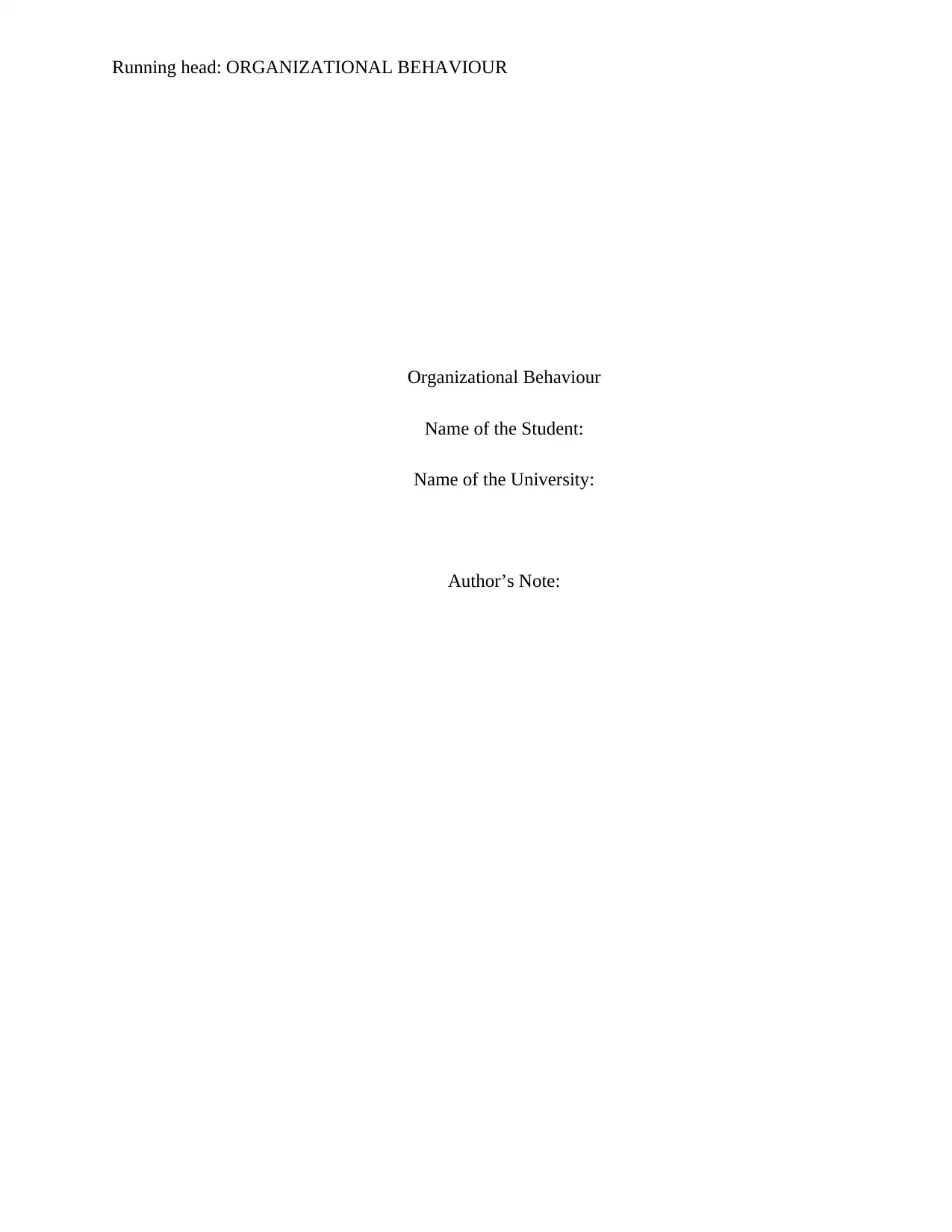
Running head: ORGANIZATIONAL BEHAVIOUR
Organizational Behaviour
Name of the Student:
Name of the University:
Author’s Note:
Organizational Behaviour
Name of the Student:
Name of the University:
Author’s Note:
Paraphrase This Document
Need a fresh take? Get an instant paraphrase of this document with our AI Paraphraser
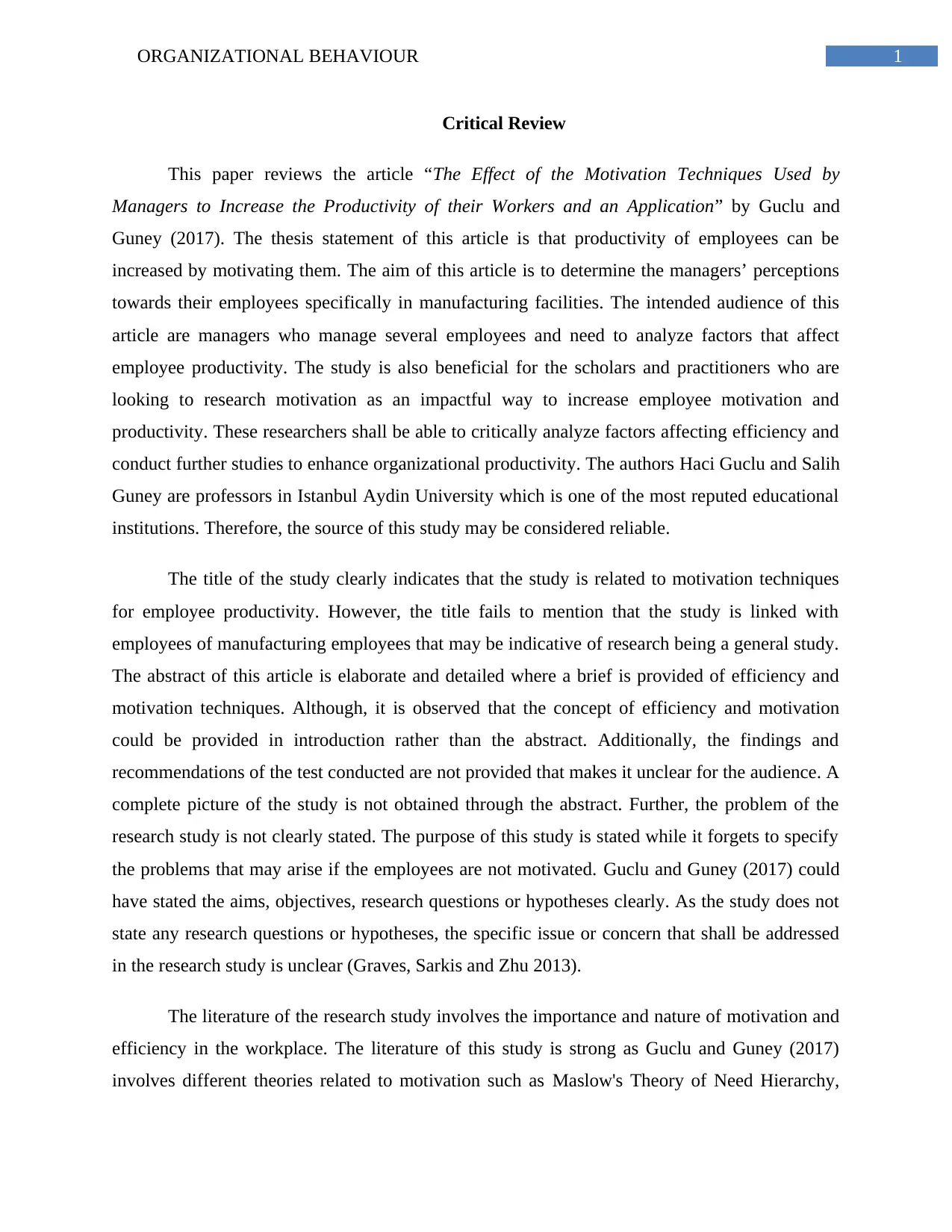
1ORGANIZATIONAL BEHAVIOUR
Critical Review
This paper reviews the article “The Effect of the Motivation Techniques Used by
Managers to Increase the Productivity of their Workers and an Application” by Guclu and
Guney (2017). The thesis statement of this article is that productivity of employees can be
increased by motivating them. The aim of this article is to determine the managers’ perceptions
towards their employees specifically in manufacturing facilities. The intended audience of this
article are managers who manage several employees and need to analyze factors that affect
employee productivity. The study is also beneficial for the scholars and practitioners who are
looking to research motivation as an impactful way to increase employee motivation and
productivity. These researchers shall be able to critically analyze factors affecting efficiency and
conduct further studies to enhance organizational productivity. The authors Haci Guclu and Salih
Guney are professors in Istanbul Aydin University which is one of the most reputed educational
institutions. Therefore, the source of this study may be considered reliable.
The title of the study clearly indicates that the study is related to motivation techniques
for employee productivity. However, the title fails to mention that the study is linked with
employees of manufacturing employees that may be indicative of research being a general study.
The abstract of this article is elaborate and detailed where a brief is provided of efficiency and
motivation techniques. Although, it is observed that the concept of efficiency and motivation
could be provided in introduction rather than the abstract. Additionally, the findings and
recommendations of the test conducted are not provided that makes it unclear for the audience. A
complete picture of the study is not obtained through the abstract. Further, the problem of the
research study is not clearly stated. The purpose of this study is stated while it forgets to specify
the problems that may arise if the employees are not motivated. Guclu and Guney (2017) could
have stated the aims, objectives, research questions or hypotheses clearly. As the study does not
state any research questions or hypotheses, the specific issue or concern that shall be addressed
in the research study is unclear (Graves, Sarkis and Zhu 2013).
The literature of the research study involves the importance and nature of motivation and
efficiency in the workplace. The literature of this study is strong as Guclu and Guney (2017)
involves different theories related to motivation such as Maslow's Theory of Need Hierarchy,
Critical Review
This paper reviews the article “The Effect of the Motivation Techniques Used by
Managers to Increase the Productivity of their Workers and an Application” by Guclu and
Guney (2017). The thesis statement of this article is that productivity of employees can be
increased by motivating them. The aim of this article is to determine the managers’ perceptions
towards their employees specifically in manufacturing facilities. The intended audience of this
article are managers who manage several employees and need to analyze factors that affect
employee productivity. The study is also beneficial for the scholars and practitioners who are
looking to research motivation as an impactful way to increase employee motivation and
productivity. These researchers shall be able to critically analyze factors affecting efficiency and
conduct further studies to enhance organizational productivity. The authors Haci Guclu and Salih
Guney are professors in Istanbul Aydin University which is one of the most reputed educational
institutions. Therefore, the source of this study may be considered reliable.
The title of the study clearly indicates that the study is related to motivation techniques
for employee productivity. However, the title fails to mention that the study is linked with
employees of manufacturing employees that may be indicative of research being a general study.
The abstract of this article is elaborate and detailed where a brief is provided of efficiency and
motivation techniques. Although, it is observed that the concept of efficiency and motivation
could be provided in introduction rather than the abstract. Additionally, the findings and
recommendations of the test conducted are not provided that makes it unclear for the audience. A
complete picture of the study is not obtained through the abstract. Further, the problem of the
research study is not clearly stated. The purpose of this study is stated while it forgets to specify
the problems that may arise if the employees are not motivated. Guclu and Guney (2017) could
have stated the aims, objectives, research questions or hypotheses clearly. As the study does not
state any research questions or hypotheses, the specific issue or concern that shall be addressed
in the research study is unclear (Graves, Sarkis and Zhu 2013).
The literature of the research study involves the importance and nature of motivation and
efficiency in the workplace. The literature of this study is strong as Guclu and Guney (2017)
involves different theories related to motivation such as Maslow's Theory of Need Hierarchy,
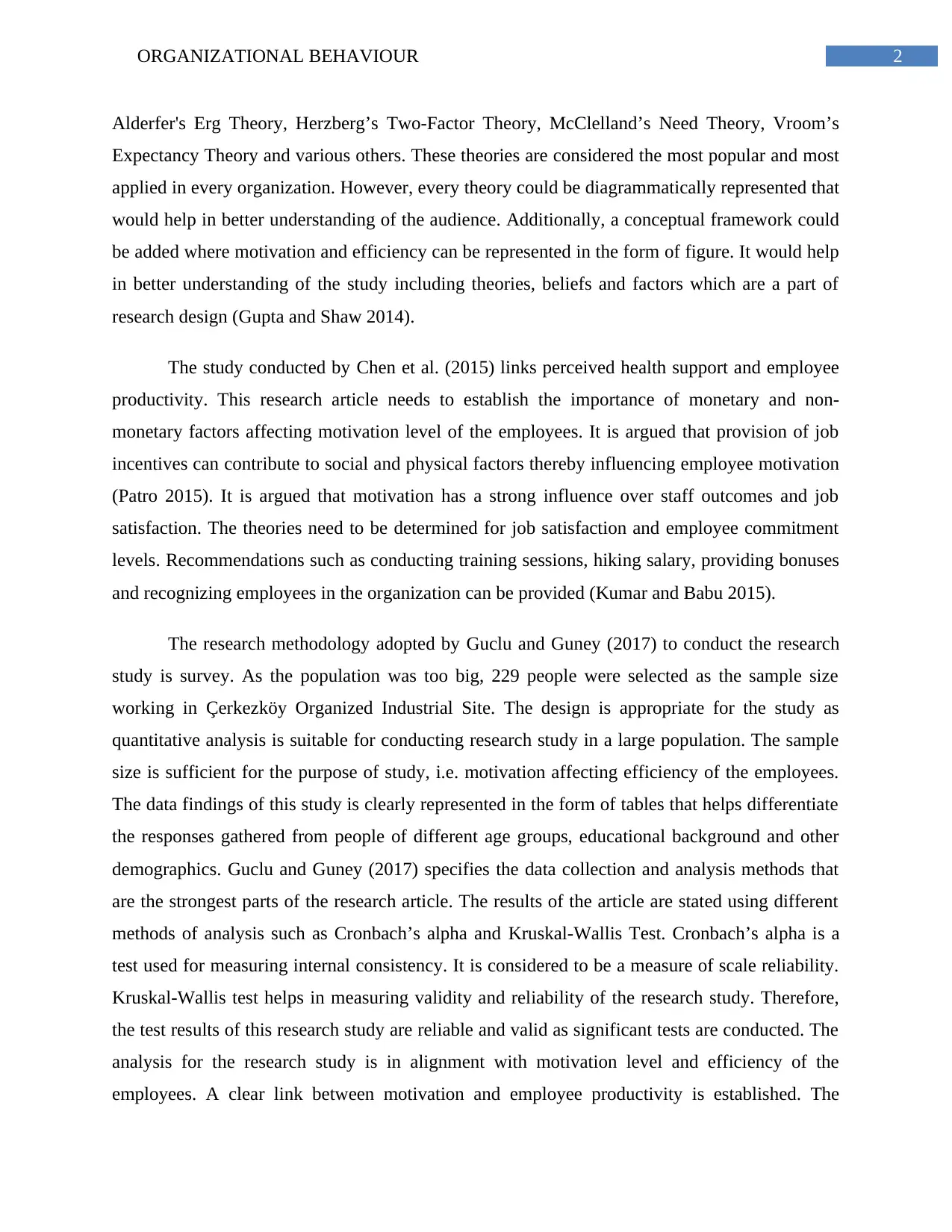
2ORGANIZATIONAL BEHAVIOUR
Alderfer's Erg Theory, Herzberg’s Two-Factor Theory, McClelland’s Need Theory, Vroom’s
Expectancy Theory and various others. These theories are considered the most popular and most
applied in every organization. However, every theory could be diagrammatically represented that
would help in better understanding of the audience. Additionally, a conceptual framework could
be added where motivation and efficiency can be represented in the form of figure. It would help
in better understanding of the study including theories, beliefs and factors which are a part of
research design (Gupta and Shaw 2014).
The study conducted by Chen et al. (2015) links perceived health support and employee
productivity. This research article needs to establish the importance of monetary and non-
monetary factors affecting motivation level of the employees. It is argued that provision of job
incentives can contribute to social and physical factors thereby influencing employee motivation
(Patro 2015). It is argued that motivation has a strong influence over staff outcomes and job
satisfaction. The theories need to be determined for job satisfaction and employee commitment
levels. Recommendations such as conducting training sessions, hiking salary, providing bonuses
and recognizing employees in the organization can be provided (Kumar and Babu 2015).
The research methodology adopted by Guclu and Guney (2017) to conduct the research
study is survey. As the population was too big, 229 people were selected as the sample size
working in Çerkezköy Organized Industrial Site. The design is appropriate for the study as
quantitative analysis is suitable for conducting research study in a large population. The sample
size is sufficient for the purpose of study, i.e. motivation affecting efficiency of the employees.
The data findings of this study is clearly represented in the form of tables that helps differentiate
the responses gathered from people of different age groups, educational background and other
demographics. Guclu and Guney (2017) specifies the data collection and analysis methods that
are the strongest parts of the research article. The results of the article are stated using different
methods of analysis such as Cronbach’s alpha and Kruskal-Wallis Test. Cronbach’s alpha is a
test used for measuring internal consistency. It is considered to be a measure of scale reliability.
Kruskal-Wallis test helps in measuring validity and reliability of the research study. Therefore,
the test results of this research study are reliable and valid as significant tests are conducted. The
analysis for the research study is in alignment with motivation level and efficiency of the
employees. A clear link between motivation and employee productivity is established. The
Alderfer's Erg Theory, Herzberg’s Two-Factor Theory, McClelland’s Need Theory, Vroom’s
Expectancy Theory and various others. These theories are considered the most popular and most
applied in every organization. However, every theory could be diagrammatically represented that
would help in better understanding of the audience. Additionally, a conceptual framework could
be added where motivation and efficiency can be represented in the form of figure. It would help
in better understanding of the study including theories, beliefs and factors which are a part of
research design (Gupta and Shaw 2014).
The study conducted by Chen et al. (2015) links perceived health support and employee
productivity. This research article needs to establish the importance of monetary and non-
monetary factors affecting motivation level of the employees. It is argued that provision of job
incentives can contribute to social and physical factors thereby influencing employee motivation
(Patro 2015). It is argued that motivation has a strong influence over staff outcomes and job
satisfaction. The theories need to be determined for job satisfaction and employee commitment
levels. Recommendations such as conducting training sessions, hiking salary, providing bonuses
and recognizing employees in the organization can be provided (Kumar and Babu 2015).
The research methodology adopted by Guclu and Guney (2017) to conduct the research
study is survey. As the population was too big, 229 people were selected as the sample size
working in Çerkezköy Organized Industrial Site. The design is appropriate for the study as
quantitative analysis is suitable for conducting research study in a large population. The sample
size is sufficient for the purpose of study, i.e. motivation affecting efficiency of the employees.
The data findings of this study is clearly represented in the form of tables that helps differentiate
the responses gathered from people of different age groups, educational background and other
demographics. Guclu and Guney (2017) specifies the data collection and analysis methods that
are the strongest parts of the research article. The results of the article are stated using different
methods of analysis such as Cronbach’s alpha and Kruskal-Wallis Test. Cronbach’s alpha is a
test used for measuring internal consistency. It is considered to be a measure of scale reliability.
Kruskal-Wallis test helps in measuring validity and reliability of the research study. Therefore,
the test results of this research study are reliable and valid as significant tests are conducted. The
analysis for the research study is in alignment with motivation level and efficiency of the
employees. A clear link between motivation and employee productivity is established. The
⊘ This is a preview!⊘
Do you want full access?
Subscribe today to unlock all pages.

Trusted by 1+ million students worldwide
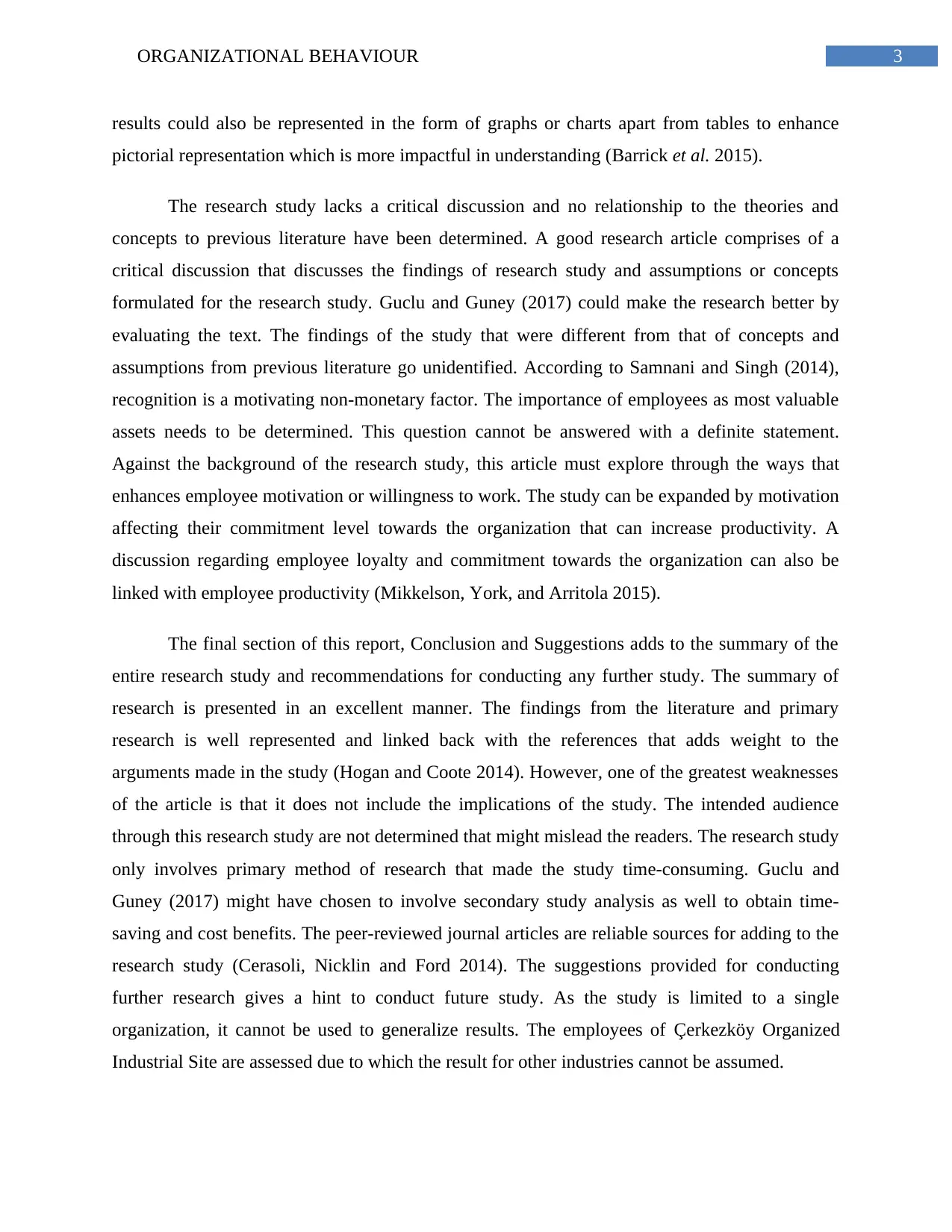
3ORGANIZATIONAL BEHAVIOUR
results could also be represented in the form of graphs or charts apart from tables to enhance
pictorial representation which is more impactful in understanding (Barrick et al. 2015).
The research study lacks a critical discussion and no relationship to the theories and
concepts to previous literature have been determined. A good research article comprises of a
critical discussion that discusses the findings of research study and assumptions or concepts
formulated for the research study. Guclu and Guney (2017) could make the research better by
evaluating the text. The findings of the study that were different from that of concepts and
assumptions from previous literature go unidentified. According to Samnani and Singh (2014),
recognition is a motivating non-monetary factor. The importance of employees as most valuable
assets needs to be determined. This question cannot be answered with a definite statement.
Against the background of the research study, this article must explore through the ways that
enhances employee motivation or willingness to work. The study can be expanded by motivation
affecting their commitment level towards the organization that can increase productivity. A
discussion regarding employee loyalty and commitment towards the organization can also be
linked with employee productivity (Mikkelson, York, and Arritola 2015).
The final section of this report, Conclusion and Suggestions adds to the summary of the
entire research study and recommendations for conducting any further study. The summary of
research is presented in an excellent manner. The findings from the literature and primary
research is well represented and linked back with the references that adds weight to the
arguments made in the study (Hogan and Coote 2014). However, one of the greatest weaknesses
of the article is that it does not include the implications of the study. The intended audience
through this research study are not determined that might mislead the readers. The research study
only involves primary method of research that made the study time-consuming. Guclu and
Guney (2017) might have chosen to involve secondary study analysis as well to obtain time-
saving and cost benefits. The peer-reviewed journal articles are reliable sources for adding to the
research study (Cerasoli, Nicklin and Ford 2014). The suggestions provided for conducting
further research gives a hint to conduct future study. As the study is limited to a single
organization, it cannot be used to generalize results. The employees of Çerkezköy Organized
Industrial Site are assessed due to which the result for other industries cannot be assumed.
results could also be represented in the form of graphs or charts apart from tables to enhance
pictorial representation which is more impactful in understanding (Barrick et al. 2015).
The research study lacks a critical discussion and no relationship to the theories and
concepts to previous literature have been determined. A good research article comprises of a
critical discussion that discusses the findings of research study and assumptions or concepts
formulated for the research study. Guclu and Guney (2017) could make the research better by
evaluating the text. The findings of the study that were different from that of concepts and
assumptions from previous literature go unidentified. According to Samnani and Singh (2014),
recognition is a motivating non-monetary factor. The importance of employees as most valuable
assets needs to be determined. This question cannot be answered with a definite statement.
Against the background of the research study, this article must explore through the ways that
enhances employee motivation or willingness to work. The study can be expanded by motivation
affecting their commitment level towards the organization that can increase productivity. A
discussion regarding employee loyalty and commitment towards the organization can also be
linked with employee productivity (Mikkelson, York, and Arritola 2015).
The final section of this report, Conclusion and Suggestions adds to the summary of the
entire research study and recommendations for conducting any further study. The summary of
research is presented in an excellent manner. The findings from the literature and primary
research is well represented and linked back with the references that adds weight to the
arguments made in the study (Hogan and Coote 2014). However, one of the greatest weaknesses
of the article is that it does not include the implications of the study. The intended audience
through this research study are not determined that might mislead the readers. The research study
only involves primary method of research that made the study time-consuming. Guclu and
Guney (2017) might have chosen to involve secondary study analysis as well to obtain time-
saving and cost benefits. The peer-reviewed journal articles are reliable sources for adding to the
research study (Cerasoli, Nicklin and Ford 2014). The suggestions provided for conducting
further research gives a hint to conduct future study. As the study is limited to a single
organization, it cannot be used to generalize results. The employees of Çerkezköy Organized
Industrial Site are assessed due to which the result for other industries cannot be assumed.
Paraphrase This Document
Need a fresh take? Get an instant paraphrase of this document with our AI Paraphraser
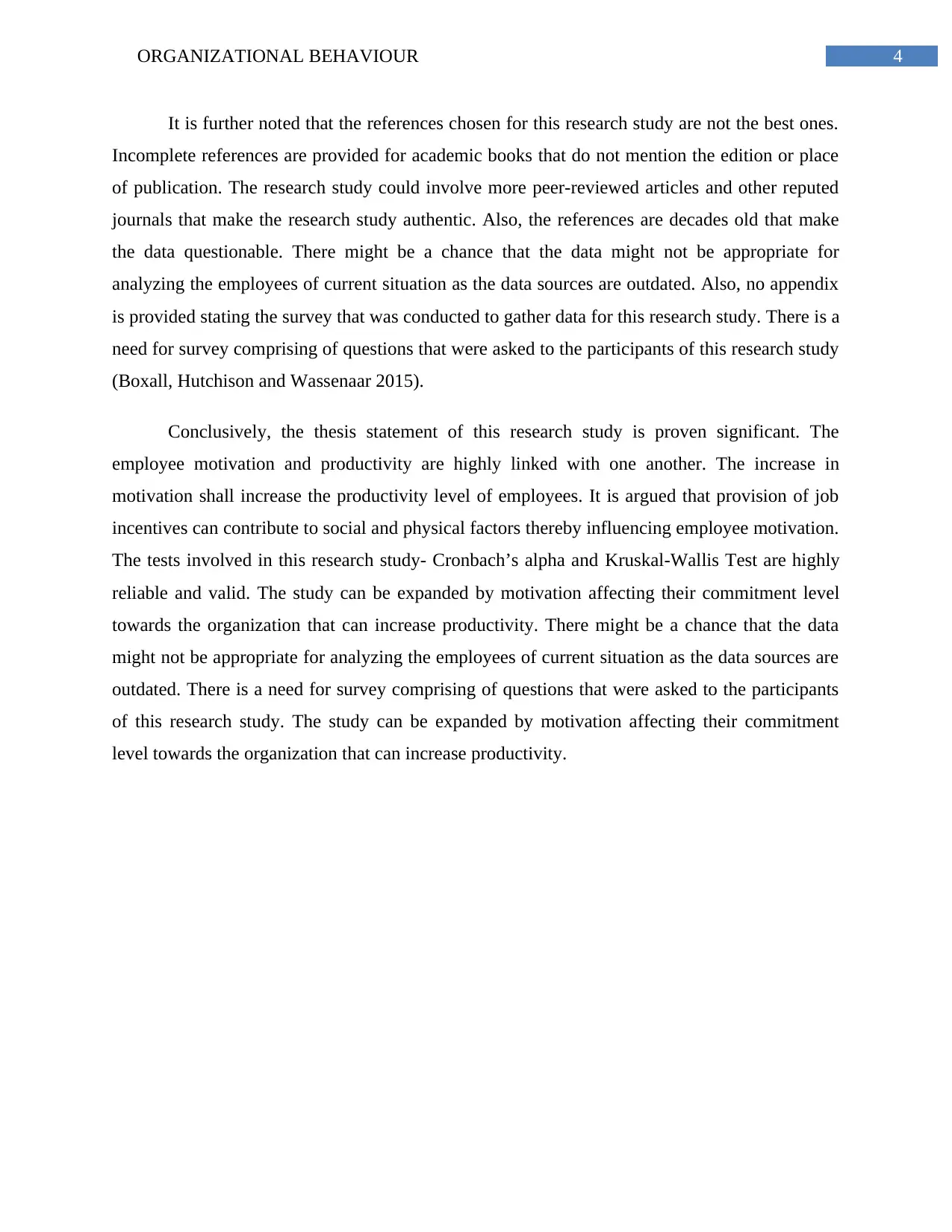
4ORGANIZATIONAL BEHAVIOUR
It is further noted that the references chosen for this research study are not the best ones.
Incomplete references are provided for academic books that do not mention the edition or place
of publication. The research study could involve more peer-reviewed articles and other reputed
journals that make the research study authentic. Also, the references are decades old that make
the data questionable. There might be a chance that the data might not be appropriate for
analyzing the employees of current situation as the data sources are outdated. Also, no appendix
is provided stating the survey that was conducted to gather data for this research study. There is a
need for survey comprising of questions that were asked to the participants of this research study
(Boxall, Hutchison and Wassenaar 2015).
Conclusively, the thesis statement of this research study is proven significant. The
employee motivation and productivity are highly linked with one another. The increase in
motivation shall increase the productivity level of employees. It is argued that provision of job
incentives can contribute to social and physical factors thereby influencing employee motivation.
The tests involved in this research study- Cronbach’s alpha and Kruskal-Wallis Test are highly
reliable and valid. The study can be expanded by motivation affecting their commitment level
towards the organization that can increase productivity. There might be a chance that the data
might not be appropriate for analyzing the employees of current situation as the data sources are
outdated. There is a need for survey comprising of questions that were asked to the participants
of this research study. The study can be expanded by motivation affecting their commitment
level towards the organization that can increase productivity.
It is further noted that the references chosen for this research study are not the best ones.
Incomplete references are provided for academic books that do not mention the edition or place
of publication. The research study could involve more peer-reviewed articles and other reputed
journals that make the research study authentic. Also, the references are decades old that make
the data questionable. There might be a chance that the data might not be appropriate for
analyzing the employees of current situation as the data sources are outdated. Also, no appendix
is provided stating the survey that was conducted to gather data for this research study. There is a
need for survey comprising of questions that were asked to the participants of this research study
(Boxall, Hutchison and Wassenaar 2015).
Conclusively, the thesis statement of this research study is proven significant. The
employee motivation and productivity are highly linked with one another. The increase in
motivation shall increase the productivity level of employees. It is argued that provision of job
incentives can contribute to social and physical factors thereby influencing employee motivation.
The tests involved in this research study- Cronbach’s alpha and Kruskal-Wallis Test are highly
reliable and valid. The study can be expanded by motivation affecting their commitment level
towards the organization that can increase productivity. There might be a chance that the data
might not be appropriate for analyzing the employees of current situation as the data sources are
outdated. There is a need for survey comprising of questions that were asked to the participants
of this research study. The study can be expanded by motivation affecting their commitment
level towards the organization that can increase productivity.
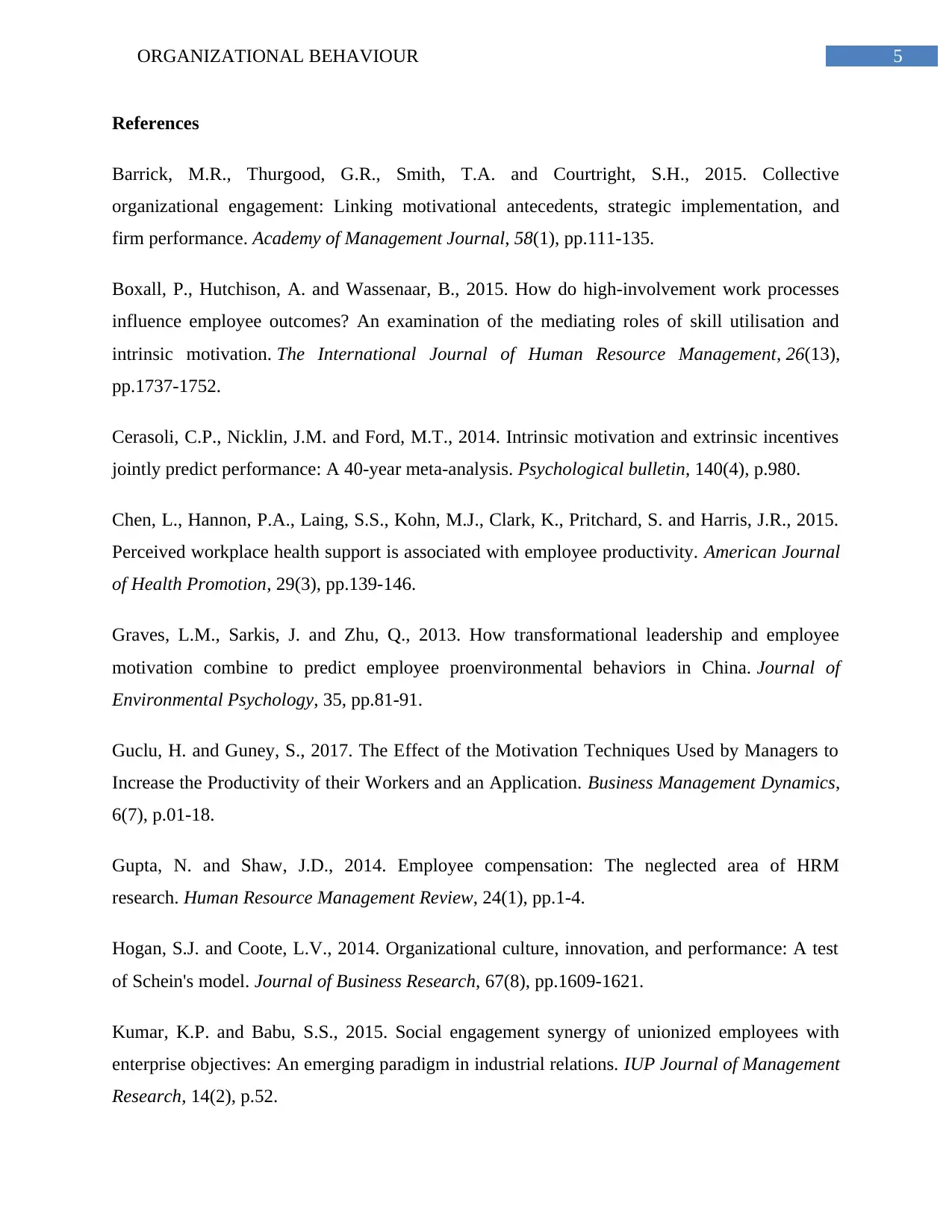
5ORGANIZATIONAL BEHAVIOUR
References
Barrick, M.R., Thurgood, G.R., Smith, T.A. and Courtright, S.H., 2015. Collective
organizational engagement: Linking motivational antecedents, strategic implementation, and
firm performance. Academy of Management Journal, 58(1), pp.111-135.
Boxall, P., Hutchison, A. and Wassenaar, B., 2015. How do high-involvement work processes
influence employee outcomes? An examination of the mediating roles of skill utilisation and
intrinsic motivation. The International Journal of Human Resource Management, 26(13),
pp.1737-1752.
Cerasoli, C.P., Nicklin, J.M. and Ford, M.T., 2014. Intrinsic motivation and extrinsic incentives
jointly predict performance: A 40-year meta-analysis. Psychological bulletin, 140(4), p.980.
Chen, L., Hannon, P.A., Laing, S.S., Kohn, M.J., Clark, K., Pritchard, S. and Harris, J.R., 2015.
Perceived workplace health support is associated with employee productivity. American Journal
of Health Promotion, 29(3), pp.139-146.
Graves, L.M., Sarkis, J. and Zhu, Q., 2013. How transformational leadership and employee
motivation combine to predict employee proenvironmental behaviors in China. Journal of
Environmental Psychology, 35, pp.81-91.
Guclu, H. and Guney, S., 2017. The Effect of the Motivation Techniques Used by Managers to
Increase the Productivity of their Workers and an Application. Business Management Dynamics,
6(7), p.01-18.
Gupta, N. and Shaw, J.D., 2014. Employee compensation: The neglected area of HRM
research. Human Resource Management Review, 24(1), pp.1-4.
Hogan, S.J. and Coote, L.V., 2014. Organizational culture, innovation, and performance: A test
of Schein's model. Journal of Business Research, 67(8), pp.1609-1621.
Kumar, K.P. and Babu, S.S., 2015. Social engagement synergy of unionized employees with
enterprise objectives: An emerging paradigm in industrial relations. IUP Journal of Management
Research, 14(2), p.52.
References
Barrick, M.R., Thurgood, G.R., Smith, T.A. and Courtright, S.H., 2015. Collective
organizational engagement: Linking motivational antecedents, strategic implementation, and
firm performance. Academy of Management Journal, 58(1), pp.111-135.
Boxall, P., Hutchison, A. and Wassenaar, B., 2015. How do high-involvement work processes
influence employee outcomes? An examination of the mediating roles of skill utilisation and
intrinsic motivation. The International Journal of Human Resource Management, 26(13),
pp.1737-1752.
Cerasoli, C.P., Nicklin, J.M. and Ford, M.T., 2014. Intrinsic motivation and extrinsic incentives
jointly predict performance: A 40-year meta-analysis. Psychological bulletin, 140(4), p.980.
Chen, L., Hannon, P.A., Laing, S.S., Kohn, M.J., Clark, K., Pritchard, S. and Harris, J.R., 2015.
Perceived workplace health support is associated with employee productivity. American Journal
of Health Promotion, 29(3), pp.139-146.
Graves, L.M., Sarkis, J. and Zhu, Q., 2013. How transformational leadership and employee
motivation combine to predict employee proenvironmental behaviors in China. Journal of
Environmental Psychology, 35, pp.81-91.
Guclu, H. and Guney, S., 2017. The Effect of the Motivation Techniques Used by Managers to
Increase the Productivity of their Workers and an Application. Business Management Dynamics,
6(7), p.01-18.
Gupta, N. and Shaw, J.D., 2014. Employee compensation: The neglected area of HRM
research. Human Resource Management Review, 24(1), pp.1-4.
Hogan, S.J. and Coote, L.V., 2014. Organizational culture, innovation, and performance: A test
of Schein's model. Journal of Business Research, 67(8), pp.1609-1621.
Kumar, K.P. and Babu, S.S., 2015. Social engagement synergy of unionized employees with
enterprise objectives: An emerging paradigm in industrial relations. IUP Journal of Management
Research, 14(2), p.52.
⊘ This is a preview!⊘
Do you want full access?
Subscribe today to unlock all pages.

Trusted by 1+ million students worldwide
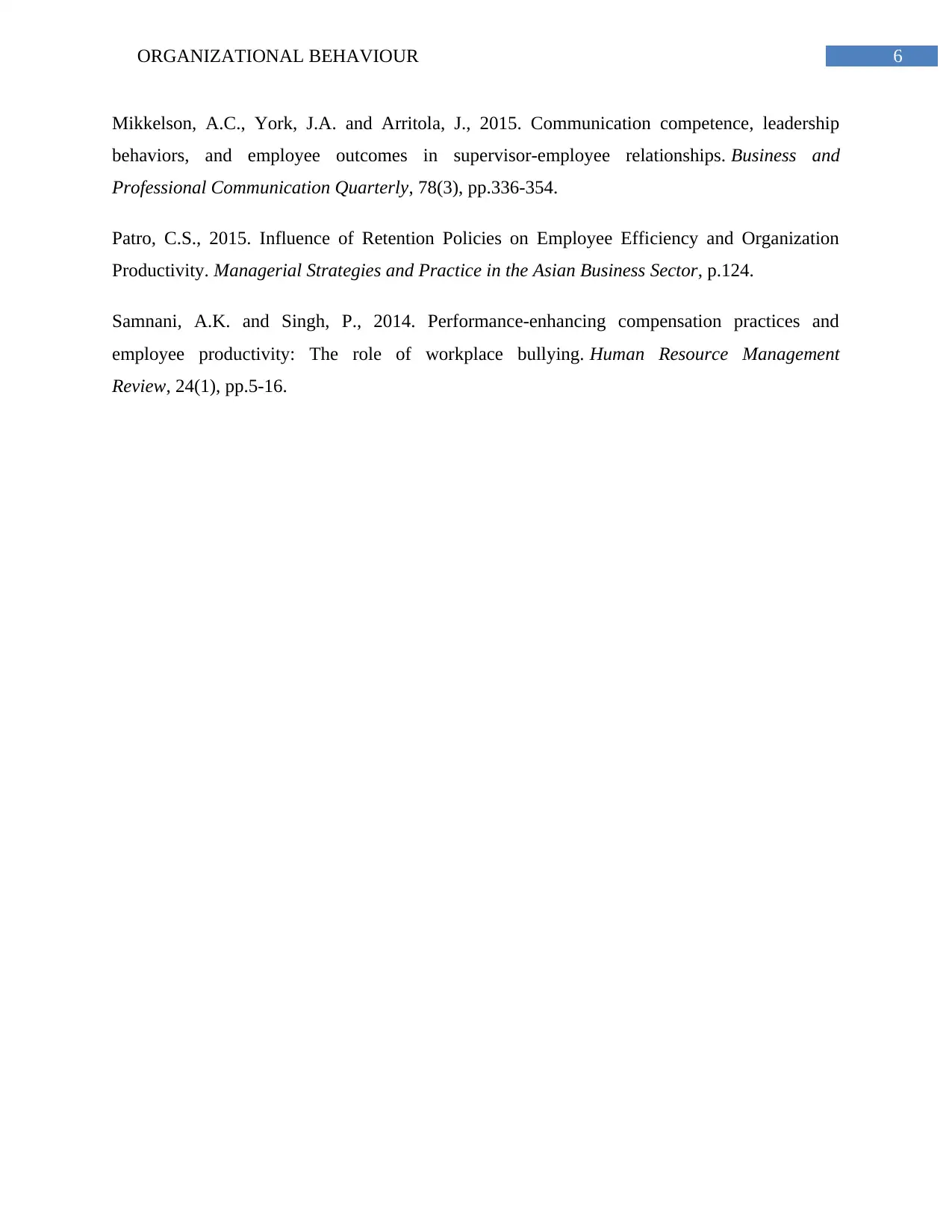
6ORGANIZATIONAL BEHAVIOUR
Mikkelson, A.C., York, J.A. and Arritola, J., 2015. Communication competence, leadership
behaviors, and employee outcomes in supervisor-employee relationships. Business and
Professional Communication Quarterly, 78(3), pp.336-354.
Patro, C.S., 2015. Influence of Retention Policies on Employee Efficiency and Organization
Productivity. Managerial Strategies and Practice in the Asian Business Sector, p.124.
Samnani, A.K. and Singh, P., 2014. Performance-enhancing compensation practices and
employee productivity: The role of workplace bullying. Human Resource Management
Review, 24(1), pp.5-16.
Mikkelson, A.C., York, J.A. and Arritola, J., 2015. Communication competence, leadership
behaviors, and employee outcomes in supervisor-employee relationships. Business and
Professional Communication Quarterly, 78(3), pp.336-354.
Patro, C.S., 2015. Influence of Retention Policies on Employee Efficiency and Organization
Productivity. Managerial Strategies and Practice in the Asian Business Sector, p.124.
Samnani, A.K. and Singh, P., 2014. Performance-enhancing compensation practices and
employee productivity: The role of workplace bullying. Human Resource Management
Review, 24(1), pp.5-16.
1 out of 7
Related Documents
Your All-in-One AI-Powered Toolkit for Academic Success.
+13062052269
info@desklib.com
Available 24*7 on WhatsApp / Email
![[object Object]](/_next/static/media/star-bottom.7253800d.svg)
Unlock your academic potential
Copyright © 2020–2025 A2Z Services. All Rights Reserved. Developed and managed by ZUCOL.





